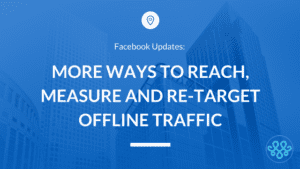
A shopping basket in one hand and a smartphone in the other. Shoppers are now using mobile devices to do research, compare prices and make their final purchase. While people use mobile in 45% of all shopping outings, the majority of sales still happen in-store. As a matter of fact, more than 90% of retail sales still take place in-store.
Even with this comes challenges. One major setback for brick-and-mortar businesses today is measuring the impact of their online advertising campaigns in comparison with store visits and sales. Over the past year, Facebook has introduced impactful solutions to help marketers understand this data better.
PREVIOUS FACEBOOK UPDATES
Local Awareness Ads
Whether you have a single store or many locations, these Facebook ads aim to bring more foot traffic to your business. The ads show people the stores nearest to them and offer convenient call-to-actions such as “Get Directions.” This makes it easier for people to shop at the store nearest to them.
Native Store Locator
This feature goes hand-in-hand with local awareness ads. In addition, it gives an interactive map to help people find and navigate to the nearest store location. Without leaving the app, a person can view the address, hours, phone number, website and travel time for each store.
Store Visits Objective
A metric implemented in Ads Reporting that helps advertisers better understand their store traffic and store purchases after running local awareness ads. It also complements current ads reporting to provide a more complete picture.
Offline Conversions API
This allows brick-and-mortar stores to see the correlation of their in-store sales with their Facebook ad campaigns. With Offline Conversions API, businesses can match transaction data from their customer database or point-of-sale system to Facebook Ads Reporting. This helps the businesses using the platform to better understand the effectiveness of their ads in real-time.
All of these features encourage and measure foot traffic and in-store sales, giving businesses more leverage and information to improve Facebook their campaign ad performance.
Now, Facebook introduces more ways to help marketers better connect with their customers by re-engaging their offline audiences on Facebook. Since launching past updates thousands of companies have used Facebook’s offline conversion tool to measure the impact of their campaigns on foot traffic & offline purchases. Now instead of just measuring that information, you can use it for more of your business’s advantage. New updates allow you to reach & re-target customers that have purchased “offline” and who have visited your store.
NEW FACEBOOK UPDATES:
Building Custom Audiences
This now enables businesses to re-engage shoppers based on their interactions through “offline” channels such as stores. According to Facebook, an example is of a real estate company “that can automatically show an ad with their latest house listings to people who have called to schedule an open house tour in the last 30 days.” Businesses can also create lookalike audiences to find new potential shoppers. Lookalike audiences share characteristics with customers in the original list.
Store Visits Objective
A priority for marketers is still to be driving foot traffic to store locations. Many businesses are already doing this with the store visits objective. Facebook store visits reporting is an estimated metric based on information from people with location services enabled on their phone. This helps businesses understand the impact of their ads on foot traffic to their stores.
Select businesses that are eligible for store visits reporting can now also create custom audiences made up of people who have recently visited their store. This feature allows businesses to re-engage in-store audiences with more relevant and meaningful campaigns. Then, they can create lookalike audiences based on them.
According to Facebook, an example is an apparel brand may use these custom audiences to show an ad with their new winter arrivals to people who have recently visited their locations. Another example is that they can also choose to exclude in-store customers, for instance, when running a promotion available for only new customers.
Facebook has designed these features carefully to ensure people’s privacy. In Ads Preferences, you can manage the custom audiences and interest groups that influence ads you see on Facebook. In conclusion, managing your online traffic analytics can be time-consuming, and may not feel like a priority for your business. Solve this problem by handing it over to the experts.



